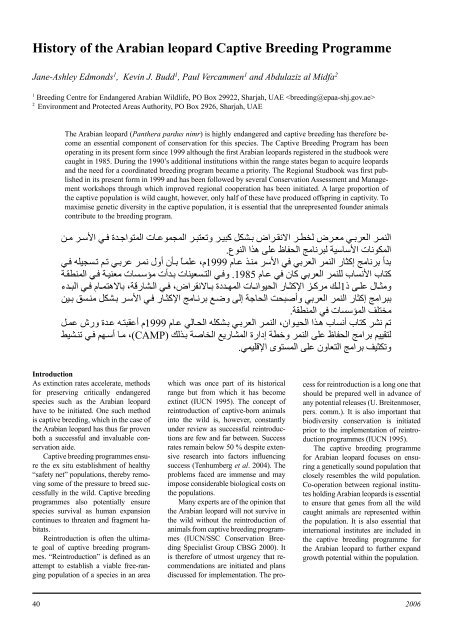Status and Conservation of the Leopard on the Arabian Peninsula ...
Status and Conservation of the Leopard on the Arabian Peninsula ...
Status and Conservation of the Leopard on the Arabian Peninsula ...
Create successful ePaper yourself
Turn your PDF publications into a flip-book with our unique Google optimized e-Paper software.
History <str<strong>on</strong>g>of</str<strong>on</strong>g> <str<strong>on</strong>g>the</str<strong>on</strong>g> <strong>Arabian</strong> leopard Captive Breeding Programme<br />
Jane-Ashley Edm<strong>on</strong>ds 1 , Kevin J. Budd 1 , Paul Vercammen 1 <str<strong>on</strong>g>and</str<strong>on</strong>g> Abdulaziz al Midfa 2<br />
1 Breeding Centre for Endangered <strong>Arabian</strong> Wildlife, PO Box 29922, Sharjah, UAE <br />
2 Envir<strong>on</strong>ment <str<strong>on</strong>g>and</str<strong>on</strong>g> Protected Areas Authority, PO Box 2926, Sharjah, UAE<br />
The <strong>Arabian</strong> leopard (Pan<str<strong>on</strong>g>the</str<strong>on</strong>g>ra pardus nimr) is highly endangered <str<strong>on</strong>g>and</str<strong>on</strong>g> captive breeding has <str<strong>on</strong>g>the</str<strong>on</strong>g>refore become<br />
an essential comp<strong>on</strong>ent <str<strong>on</strong>g>of</str<strong>on</strong>g> c<strong>on</strong>servati<strong>on</strong> for this species. The Captive Breeding Program has been<br />
operating in its present form since 1999 although <str<strong>on</strong>g>the</str<strong>on</strong>g> first <strong>Arabian</strong> leopards registered in <str<strong>on</strong>g>the</str<strong>on</strong>g> studbook were<br />
caught in 1985. During <str<strong>on</strong>g>the</str<strong>on</strong>g> 1990’s additi<strong>on</strong>al instituti<strong>on</strong>s within <str<strong>on</strong>g>the</str<strong>on</strong>g> range states began to acquire leopards<br />
<str<strong>on</strong>g>and</str<strong>on</strong>g> <str<strong>on</strong>g>the</str<strong>on</strong>g> need for a coordinated breeding program became a priority. The Regi<strong>on</strong>al Studbook was first published<br />
in its present form in 1999 <str<strong>on</strong>g>and</str<strong>on</strong>g> has been followed by several <str<strong>on</strong>g>C<strong>on</strong>servati<strong>on</strong></str<strong>on</strong>g> Assessment <str<strong>on</strong>g>and</str<strong>on</strong>g> Management<br />
workshops through which improved regi<strong>on</strong>al cooperati<strong>on</strong> has been initiated. A large proporti<strong>on</strong> <str<strong>on</strong>g>of</str<strong>on</strong>g><br />
<str<strong>on</strong>g>the</str<strong>on</strong>g> captive populati<strong>on</strong> is wild caught, however, <strong>on</strong>ly half <str<strong>on</strong>g>of</str<strong>on</strong>g> <str<strong>on</strong>g>the</str<strong>on</strong>g>se have produced <str<strong>on</strong>g>of</str<strong>on</strong>g>fspring in captivity. To<br />
maximise genetic diversity in <str<strong>on</strong>g>the</str<strong>on</strong>g> captive populati<strong>on</strong>, it is essential that <str<strong>on</strong>g>the</str<strong>on</strong>g> unrepresented founder animals<br />
c<strong>on</strong>tribute to <str<strong>on</strong>g>the</str<strong>on</strong>g> breeding program.<br />
ﻦ��ﻣ ﺮ��ﺳﻷا ﻲ��ﻓ ةﺪ��ﺟاﻮﺘﻤﻟا تﺎ��ﻋﻮﻤﺠﻤﻟا ﺮ��ﺒﺘﻌﺗو ﺮ��ﯿﺒﻛ ﻞﻜﺸ��ﺑ ضاﺮ��ﻘﻧﻻا ﺮ��ﻄﺨﻟ ضﺮ��ﻌﻣ ﻲ��ﺑﺮﻌﻟا ﺮ��ﻤﻨﻟا<br />
. عﻮﻨﻟا اﺬھ ﻰﻠﻋ ظﺎﻔﺤﻟا ﺞﻣﺎﻧﺮﺒﻟ ﺔﯿﺳﺎﺳﻷا تﺎﻧﻮﻜﻤﻟا<br />
ﻲ�ﻓ ﮫﻠﯿﺠﺴ�ﺗ ﻢ�ﺗ ﻲ�ﺑﺮﻋ ﺮ�ﻤﻧ لوأ نﺄ�ﺑ ًﺎ�ﻤﻠﻋ ،م1999<br />
مﺎ�ﻋ ﺬ�ﻨﻣ ﺮﺳﻷا ﻲﻓ ﻲﺑﺮﻌﻟا ﺮﻤﻨﻟا رﺎﺜﻛإ ﺞﻣﺎﻧﺮﺑ أﺪﺑ<br />
ﺔ�ﻘﻄﻨﻤﻟا ﻲ�ﻓ ﺔ�ﯿﻨﻌﻣ تﺎﺴ�ﺳﺆﻣ تأﺪ�ﺑ تﺎﻨﯿﻌﺴ�ﺘﻟا ﻲ�ﻓو . 1985 مﺎ�ﻋ ﻲﻓ نﺎﻛ ﻲﺑﺮﻌﻟا ﺮﻤﻨﻠﻟ بﺎﺴﻧﻷا بﺎﺘﻛ<br />
ءﺪ��ﺒﻟا ﻲ��ﻓ مﺎ��ﻤﺘھﻻﺎﺑ ،ﺔﻗرﺎﺸ��ﻟا ﻲ��ﻓ ،ضاﺮﻘﻧﻻﺎ��ﺑ<br />
ةدﺪ��ﮭﻤﻟا تﺎ��ﻧاﻮﯿﺤﻟا رﺎ��ﺜﻛﻹا ﺰ��ﻛﺮﻣ ﻚ��ﻟ1ذ<br />
ﻰ��ﻠﻋ لﺎ��ﺜﻣو<br />
ﻦﯿ�ﺑ ﻖﺴ�ﻨﻣ ﻞﻜﺸ�ﺑ ﺮ�ﺳﻷا ﻲ�ﻓ رﺎ�ﺜﻛﻹا ﺞﻣﺎ�ﻧﺮﺑ ﻊ�ﺿو ﻰﻟإ ﺔﺟﺎﺤﻟا ﺖﺤﺒﺻأو ﻲﺑﺮﻌﻟا ﺮﻤﻨﻟا رﺎﺜﻛإ ﺞﻣاﺮﺒﺑ<br />
. ﺔﻘﻄﻨﻤﻟا ﻲﻓ تﺎﺴﺳﺆﻤﻟا ﻒﻠﺘﺨﻣ<br />
ﻞ�ﻤﻋ شرو ةﺪ�ﻋ ﮫ�ﺘﺒﻘﻋأ م1999<br />
مﺎ�ﻋ ﻲﻟﺎ�ﺤﻟا ﮫﻠﻜﺸ�ﺑ ﻲ�ﺑﺮﻌﻟا ﺮ�ﻤﻨﻟا ،ناﻮ�ﯿﺤﻟا اﺬ�ھ بﺎﺴﻧأ بﺎﺘﻛ ﺮﺸﻧ ﻢﺗ<br />
ﻂﯿﺸ�ﻨﺗ ﻲ�ﻓ ﻢﮭ�ﺳأ ﺎ�ﻣ ،(<br />
CAMP)<br />
ﻚﻟﺬ�ﺑ ﺔﺻﺎﺨﻟا ﻊﯾرﺎﺸﻤﻟا ةرادإ ﺔﻄﺧو ﺮﻤﻨﻟا ﻰﻠﻋ ظﺎﻔﺤﻟا ﺞﻣاﺮﺑ ﻢﯿﯿﻘﺘﻟ<br />
. ﻲﻤﯿﻠﻗﻹا ىﻮﺘﺴﻤﻟا ﻰﻠﻋ نوﺎﻌﺘﻟا ﺞﻣاﺮﺑ ﻒﯿﺜﻜﺗو<br />
Introducti<strong>on</strong><br />
As extincti<strong>on</strong> rates accelerate, methods<br />
for preserving critically endangered<br />
species such as <str<strong>on</strong>g>the</str<strong>on</strong>g> <strong>Arabian</strong> leopard<br />
have to be initiated. One such method<br />
is captive breeding, which in <str<strong>on</strong>g>the</str<strong>on</strong>g> case <str<strong>on</strong>g>of</str<strong>on</strong>g><br />
<str<strong>on</strong>g>the</str<strong>on</strong>g> <strong>Arabian</strong> leopard has thus far proven<br />
both a successful <str<strong>on</strong>g>and</str<strong>on</strong>g> invaluable c<strong>on</strong>servati<strong>on</strong><br />
aide.<br />
Captive breeding programmes ensure<br />
<str<strong>on</strong>g>the</str<strong>on</strong>g> ex situ establishment <str<strong>on</strong>g>of</str<strong>on</strong>g> healthy<br />
“safety net” populati<strong>on</strong>s, <str<strong>on</strong>g>the</str<strong>on</strong>g>reby removing<br />
some <str<strong>on</strong>g>of</str<strong>on</strong>g> <str<strong>on</strong>g>the</str<strong>on</strong>g> pressure to breed successfully<br />
in <str<strong>on</strong>g>the</str<strong>on</strong>g> wild. Captive breeding<br />
programmes also potentially ensure<br />
species survival as human expansi<strong>on</strong><br />
c<strong>on</strong>tinues to threaten <str<strong>on</strong>g>and</str<strong>on</strong>g> fragment habitats.<br />
Reintroducti<strong>on</strong> is <str<strong>on</strong>g>of</str<strong>on</strong>g>ten <str<strong>on</strong>g>the</str<strong>on</strong>g> ultimate<br />
goal <str<strong>on</strong>g>of</str<strong>on</strong>g> captive breeding programmes.<br />
“Reintroducti<strong>on</strong>” is defined as an<br />
attempt to establish a viable free-ranging<br />
populati<strong>on</strong> <str<strong>on</strong>g>of</str<strong>on</strong>g> a species in an area<br />
which was <strong>on</strong>ce part <str<strong>on</strong>g>of</str<strong>on</strong>g> its historical<br />
range but from which it has become<br />
extinct (IUCN 1995). The c<strong>on</strong>cept <str<strong>on</strong>g>of</str<strong>on</strong>g><br />
reintroducti<strong>on</strong> <str<strong>on</strong>g>of</str<strong>on</strong>g> captive-born animals<br />
into <str<strong>on</strong>g>the</str<strong>on</strong>g> wild is, however, c<strong>on</strong>stantly<br />
under review as successful reintroducti<strong>on</strong>s<br />
are few <str<strong>on</strong>g>and</str<strong>on</strong>g> far between. Success<br />
rates remain below 50 % despite extensive<br />
research into factors influencing<br />
success (Tenhumberg et al. 2004). The<br />
problems faced are immense <str<strong>on</strong>g>and</str<strong>on</strong>g> may<br />
impose c<strong>on</strong>siderable biological costs <strong>on</strong><br />
<str<strong>on</strong>g>the</str<strong>on</strong>g> populati<strong>on</strong>s.<br />
Many experts are <str<strong>on</strong>g>of</str<strong>on</strong>g> <str<strong>on</strong>g>the</str<strong>on</strong>g> opini<strong>on</strong> that<br />
<str<strong>on</strong>g>the</str<strong>on</strong>g> <strong>Arabian</strong> leopard will not survive in<br />
<str<strong>on</strong>g>the</str<strong>on</strong>g> wild without <str<strong>on</strong>g>the</str<strong>on</strong>g> reintroducti<strong>on</strong> <str<strong>on</strong>g>of</str<strong>on</strong>g><br />
animals from captive breeding programmes<br />
(IUCN/SSC <str<strong>on</strong>g>C<strong>on</strong>servati<strong>on</strong></str<strong>on</strong>g> Breeding<br />
Specialist Group CBSG 2000). It<br />
is <str<strong>on</strong>g>the</str<strong>on</strong>g>refore <str<strong>on</strong>g>of</str<strong>on</strong>g> utmost urgency that recommendati<strong>on</strong>s<br />
are initiated <str<strong>on</strong>g>and</str<strong>on</strong>g> plans<br />
discussed for implementati<strong>on</strong>. The pro-<br />
cess for reintroducti<strong>on</strong> is a l<strong>on</strong>g <strong>on</strong>e that<br />
should be prepared well in advance <str<strong>on</strong>g>of</str<strong>on</strong>g><br />
any potential releases (U. Breitenmoser,<br />
pers. comm.). It is also important that<br />
biodiversity c<strong>on</strong>servati<strong>on</strong> is initiated<br />
prior to <str<strong>on</strong>g>the</str<strong>on</strong>g> implementati<strong>on</strong> <str<strong>on</strong>g>of</str<strong>on</strong>g> reintroducti<strong>on</strong><br />
programmes (IUCN 1995).<br />
The captive breeding programme<br />
for <strong>Arabian</strong> leopard focuses <strong>on</strong> ensuring<br />
a genetically sound populati<strong>on</strong> that<br />
closely resembles <str<strong>on</strong>g>the</str<strong>on</strong>g> wild populati<strong>on</strong>.<br />
Co-operati<strong>on</strong> between regi<strong>on</strong>al institutes<br />
holding <strong>Arabian</strong> leopards is essential<br />
to ensure that genes from all <str<strong>on</strong>g>the</str<strong>on</strong>g> wild<br />
caught animals are represented within<br />
<str<strong>on</strong>g>the</str<strong>on</strong>g> populati<strong>on</strong>. It is also essential that<br />
internati<strong>on</strong>al institutes are included in<br />
<str<strong>on</strong>g>the</str<strong>on</strong>g> captive breeding programme for<br />
<str<strong>on</strong>g>the</str<strong>on</strong>g> <strong>Arabian</strong> leopard to fur<str<strong>on</strong>g>the</str<strong>on</strong>g>r exp<str<strong>on</strong>g>and</str<strong>on</strong>g><br />
growth potential within <str<strong>on</strong>g>the</str<strong>on</strong>g> populati<strong>on</strong>.<br />
40 2006


